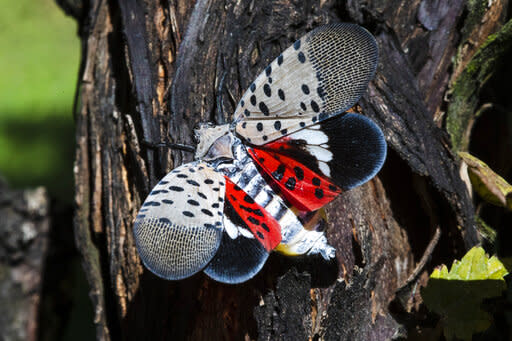Can you eat a spotted lanternfly?

(NEXSTAR) — For nearly a decade, a stunning but destructive invasive species has been spreading throughout the U.S.: the spotted lanternfly. With its dazzling spots and pair of bright red wings, it can be hard not to admire the bug – but would you consider eating it?
If you aren’t familiar, the spotted lanternfly is a moth-like insect native to China. It was first detected in the U.S. by a Pennsylvania forester in 2014. While it can’t go very far on its own — with the help of wind and clear air space, the spotted lanternfly can only travel about a mile under its own steam, Shannon Powers, press secretary for the Pennsylvania Department of Agriculture tells Nexstar — the invasive species has been found in more than a dozen states.
According to the U.S. Department of Agriculture, that includes Connecticut, Delaware, Indiana, Maryland, Massachusetts, Michigan, New Jersey, New York, North Carolina, Ohio, Rhode Island, Virginia, and West Virginia.
This insect is the spotted lanternfly’s worst enemy
The spotted lanternfly feasts off of fruit as well as ornamental and woody trees, especially the tree of heaven, a fellow invasive species native to China, according to the U.S. Department of Agriculture. Specifically, the spotted lanternfly feeds on sap from over 70 different plant species, PennState Extension explains. The damage left behind can cause the plant to stress, draining its health and potentially killing it.
The insect also poses a threat to the wine industries across many states, like New York and Michigan.
If you find an adult spotted lanternfly, like the one pictured below, agriculture officials say to destroy it. To kill the spotted lanternfly, Virginia officials say to “squash, stomp, or smash it.”
If the insect hasn’t been detected near you yet, make sure to take a photo of it, record where you saw it, and share that information with agriculture or wildlife officials before killing it.

But what about eating it?
While it isn’t an outright suggestion, the spotted lanternflies have not proven to be toxic to humans or animals, Powers says. In areas where the lanternfly is native, people have been known to consume them.
You may even find yourself eating a spotted lanternfly by-product.
As Powers explains, lanternflies largely eat sap, which they then shoot out “as what entomologists call ‘honeydew.’” It’s part of the reason why the insects are so destructive — that honeydew can coat leaves, like those on grape plants, and block photosynthesis, thereby killing the plants.
Bees, however, eat the honeydew, which can create a darker-colored honey. It does have a smokey odor, according to PennState Extension, and is not as sweet as other kinds of honey. It also carries a lingering aftertaste, but Powers says people have eaten this honey “with no ill effects.”
There are other species that will eat the lanternflies as well, Powers notes.
Research has found that birds like chickens and cardinals have been spotted eating the spotted lanternfly, Anne Johnson, an entomology doctoral candidate at Pennsylvania State University told WESA. Other insects, including praying mantises, ants, wasps, and spiders, have also been known to feast on the bug.
Don’t be mesmerized – you should kill this dazzling bug
There is even one species, known as the wheel bug, that has been known to lay its eggs next to spotted lanternfly egg masses, co-researcher and Penn State entomology professor Kelli Hoover told WESA. The wheel bugs hatch first, then wait for the spotted lanternfly eggs to hatch before devouring them.
Still, Powers warns the native species don’t appear to eat the spotted lanternfly in the droves that they occur in.
For now, officials are still warning that if you see the spotted lanternfly kill it, and if you live in an area where it isn’t known to be present, report it to local wildlife officials.
For the latest news, weather, sports, and streaming video, head to WesternSlopeNow.com.

